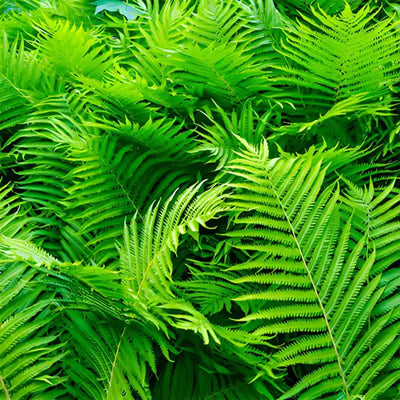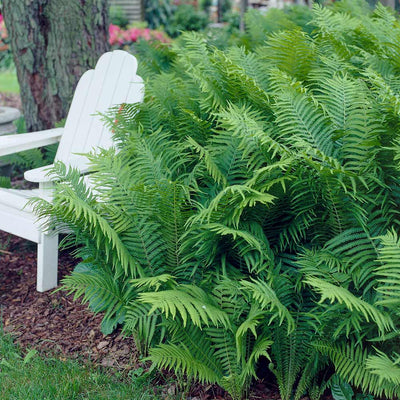Small-sized ferns: perfect for bringing big textures to shaded gardens.
Small perennial ferns easily beautify any landscape by bringing zen-like tranquility and the allure of the woods. Their finely cut fronds reflect the light in rare form, lending movement, softness, and attention to detail while easing the tension of dull shade. Since most ferns prefer filtered light and humus-rich soil, they can thrive beneath trees, along north-facing walls, beside porches, and in places where many other flowering plants fail. For low, tidy, and graceful textures, small ferns remain unsurpassed.
Why select small ferns?
Compact design ferns simplify the task of having to plan a garden. Their lacy fronds sprinkle airy textures while dancing alongside other plants, and most stay in perfect sculptural form with minimal maintenance. They are ideal for the front of the mixed border, rope-like edges of paths, and within slim garden beds alongside perennial borders. Small ferns in pots are more abundantly fresh to enhance a layered look in summer when complemented with cascading stratified ivy, creeping Jenny, or sweet flag. Their roots slowly woven, woven and decayed, gradually maintaining the loose soil plants need while minimizing erosion, providing cross-sustenance for nearby shrubs and perennial plants.
Three remarkable small ferns worth knowing
New York fern
The New York fern is perfect for shady areas of the garden, these ferns have soft, yellowish-green fronds which are oval in shape, and spilt and taper at the ends, giving a delicate feathered appearance. Each plant typically grows from 12 to 24 inches with oblong fronds of about 4 inches wide. Thus, it qualifies as a small fern. Fronds develop directly from the rootstock, making for a neat and compact clump. Overall, it is best to provide New York ferns with evenly moist and slightly acid soils and offer them adequate partial to full shade. Once established, these ferns are able to endure winters of nearly negative 20 degrees Fahrenheit and, in the spring, emerge with fresh growth. New York ferns grow and hold their leaves later into the season compared to many other ferns which helps provide color to the garden once the flowers have died.
Hay Scented Fern
Whenever you would crush a leaf you would get a brand new aroma of fresh cut hay. The hay scented fern has elegant-framed lacy leaves that are 1 to 3 feet tall and 1 foot long at the center. Each leaflet has little lobe subdivisions that resemble tiny oak leaves and gives the fern extra texture. It grows in humus-rich, slightly acid soil and spreads by rhizomes to form a soft colony which is perfect for stabilizing slopes or filling shady areas of a forest. Hay scented fern should be planted in areas that would benefit from a soft, naturalistic appearance. Settled plants can survive short periods of drought as long as the plants are protected from the hot afternoon sun. The plants can survive the winter as long as temperatures do not go beyond -30 degrees Fahrenheit.
Bracken fern
Bracken can be found all over the globe including in North America, Europe, and Asia. Anywhere bracken ferns grow boast the longest triangular shaped fronds, up to 3 feet long, and have three side branches on a stalk. These ferns also go through a transformation during the summer, changing from a light to deep green, and in the fall, warm yellow. Of the ferns, bracken can tolerate the most drought, growing in slightly acid, well drained, and not very fertile soils. This plant also reproduces quickly and easily through rhizomes, and they can tolerate extreme cold, up to - 40 degress Fahrenheit.
Other worthy compact ferns
A small fern collection would also be complete with Japanese painted fern for silver and purple tones, with its delicate Maidenhair ferns, and the classic, tufted lady fern. Fro the warmer areas, adding a Christmas fern for its fronds brings a nice gloss. Within the restricted areas still, the Dwarf forms of Athyrium, and Dryopteris stand out by growing under a foot while still being perfect for containers or tight borders.
Easy Steps for Planting & Caring for Plants
A majority of smaller ferns seem to do best in soils that are rich in organic matter and have moisture, good drainage, and aeration. Before planting, incorporate compost and leaf mold. Always angle the planting area so that water never puddles around the crowns. Water deeply the first growing season, then once a week in dry periods. Each spring, add a light layer of compost and then a larger layer of slow-release fertilizer on top. To mimic the woodland floor, use shredded leaves to keep the plant roots cool and insulated. Avoid the full and direct sun in the afternoon and areas that are windy. If fronds dry out due to the heat of summer, a haircut and a good drink, sparks rejuvenation.
Design ideas that incorporate small ferns
Use small ferns to grab attention and connect layers in a shade bed. A row of New York ferns along a flagstone path helps to soften sharp contours. Hay-scented fern beneath open canopy trees creates a gentle, flowing, and natural ground cover. Bracken fern anchors a woodland corner close to mossy rocks. For color contrast, ferns go well with hosta, heuchera, astilbe, foamflower, or pulmonaria. For a taller partner, try Solomon’s seal or goat’s beard. In containers, a small fern looks great with a dwarf hydrangea and trailing vinca, perfect for a porch display.
Companions and supportive behaviors
Ferns love what many gardeners already possess. Leaf litter serves as the perfect mulch for them. Rain barrels allow you to water with gentle, chlorine-eliminated water that ferns love. For gardeners in limestone soil areas, mix in peat-free compost and pine fines to balance the pH to slightly acidic. Don’t give in to the temptation to over-fertilize ferns. A gentle, balanced feed in spring is enough for ferns as foliage plants, because they prefer consistent and gentle growth.
Mistakes and how to avoid them
Don’t let crowns soak in water. Do not plant any place where tree roots will steal all the moisture. Do not use high nitrogen fertilizers. They promote weak growth. If a fern wants to spread, like bracken or hay scented, give it a defined area or a root barrier. Otherwise, it will run into smaller neighbors. If clumps become crowded, divide them in early spring and give them extra water.
Ready to plant small ferns? Visit TN Nursery
If you want compact, reliable texture for your shade garden, start with small ferns. Choose New York fern for a refined look, hay scented fern for a soft groundcover, and bracken for naturalistic sweeps. Add a few Japanese painted or maidenhair ferns for color and airiness. You will get season long structure with little fuss. Browse healthy, garden ready selections at TN Nursery, your online source for ferns and shade companions.
FAQs
What ferns stay small?
Many species remain small in size and will fit comfortably in pot displays on porches, in rockeries, and in densely shaded beds. These include the New York fern at 12 to 18 inches, Japanese painted fern at roughly 12 to 15 inches, maidenhair at 12 to 18 inches, and dwarf lady fern at under 18 inches. They can be kept in the open sun and will not disturb other plants in the area if soil is kept evenly moist, is enriched with leaf mold or compost, and if they are coppiced regularly.
Do ferns grow in Tennessee?
Of course. Tennessee woodlands and its shaded backyards are perfect for many native and ornamental ferns. The New York fern, Christmas fern, hay scented fern, and lady fern do extremely well in the humid summers and cool winters of Tennessee if planted in gentle light with abundant, well-drained, slightly acid soil. Most of the ferns are drought resistant and do not need additional watering during the hotter months and will return each spring throughout the Tennessee zones if leaf litter is used as mulch.
What is the most cold hardy fern?
A few species of ferns are capable of surviving harsh cold weather conditions. Bracken ferns are some of the most cold hardy species of ferns able to withstand temperatures of nearly 40 degrees Fahrenheit below zero when established. Other ferns such as the christmas fern, ostrich fern, and lady fern are also capable of withstanding extremely low temperatures in the north. When planting, water and well mulched with winter mulch, make sure the soil is moist and well drained, and do not allow water to stand. Just because a plant is cold hardy does not mean that it is still evergreen; it should be expected that cold hardy ferns’ fronds will die back and reappear.
What are the 10 different ferns?
The most common ferns grown by gardeners are the New York fern, hay scented fern, bracken fern, maidenhair, Japanese painted fern, lady fern, Christmas fern, ostrich fern, cinnamon fern, and royal fern. These plants come in an array of different sizes and textures such as the extremely small, finely cut fronds of the maidenhair fern in comparison to the strong, bold plumes of the ostrich fern. Each fern should be watered carefully according to it’s light and moisture requirements; several ferns may also be combined to achieve a layered shade effect.
Is there a dwarf fern?
Yes! Nurseries carry both true dwarf selections and naturally small species. Look for dwarf lady ferns and dwarf Japanese holly ferns and miniature Athyrium and Dryopteris species that reach a maximum height of around 8 to 12 inches. Their small clumping growth forms help soften the edges of containers, fairy gardens, or the front of shady borders. To ensure the mini ferns grow tidy and compact, provide consistent moisture, a rich humus mixture, and light feeding.
Why do you put Epsom salt on ferns?
Epsom salts provide magnesium and sulfur, two secondary nutrients that aid in the production of chlorophyll and promote deeper green fronds. If a soil test shows that magnesium levels are low, a light and infrequent magnesium sulfate dose can help. Many shade beds have adequate magnesium levels, so regular, routine application of epsom salts is not needed. Many shade beds have adequate magnesium levels, so the routine application is not needed. Epsom salts should be reserved for the deficiencies.








